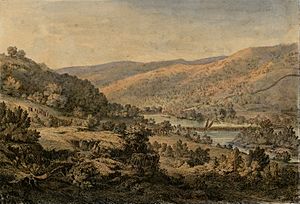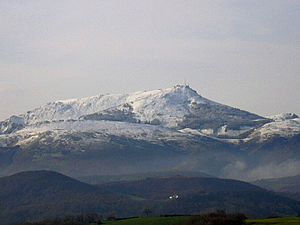Battle of the Bidassoa facts for kids
Quick facts for kids Battle of the Bidassoa (1813) |
|||||||
|---|---|---|---|---|---|---|---|
| Part of War of the Sixth Coalition | |||||||
 Battle of the Bidassoa, 9 October 1813. |
|||||||
|
|||||||
| Belligerents | |||||||
| Commanders and leaders | |||||||
| Strength | |||||||
| 62,000 | 89,000 | ||||||
| Casualties and losses | |||||||
| 1,676 17 cannons |
825-1,600 | ||||||
The Battle of the Bidassoa (also called the Battle of Larrun) happened on October 7, 1813. It was a major fight during the Peninsular War, which was part of the bigger Napoleonic Wars. In this battle, the Allied army, led by Arthur Wellesley, Duke of Wellington, managed to cross into France. They fought against the French army, led by Nicolas Soult.
The battle took place near the Bidassoa River, which forms part of the border between Spain and France, and along the Pyrenees mountains, especially around La Rhune (Larrun). The Allied forces surprised the French by crossing the river at a low tide. They quickly took control of the French defenses near the coast and in the mountains. This victory was important because it was the first time Wellington's army successfully entered France.
Contents
What Led to the Battle?
Previous Fights
Before this battle, on August 31 and September 1, 1813, Marshal Soult's French army tried to push into Spain but was stopped at the Battle of San Marcial. After that, the Allies successfully ended the Siege of San Sebastián in early September. This siege was very costly and ended with the city being badly damaged. Another French group was still holding out in the Siege of Pamplona, but they would surrender later in October. Wellington also wanted to capture French positions that were watching his troops from the Spanish side of the Bidassoa River.
Getting Ready for Battle
The French Emperor Napoleon ordered his Marshal Soult to defend the border very closely. This was because French soldiers had started to steal from their own people, and Napoleon wanted to stop this. Soult had to defend a long line of about 48 kilometers (30 miles) in the Pyrenees mountains. This area was easy to defend, but it was hard for his troops to move and communicate across the front.
Soult thought the coastal area was the strongest part of his defense. So, he put General Honoré Charles Reille and about 10,550 men there. General Antoine Louis Popon de Maucune's division defended the lower Bidassoa, and General Pierre François Xavier Boyer's division was further inland. Behind them, General Eugene-Casimir Villatte had a reserve force of over 8,000 men.
In the center, General Bertrand Clausel had about 15,300 men. His troops were spread out, with some near the Bidassoa and others around Mont La Rhune. On his far left, General Jean-Baptiste Drouet, Comte d'Erlon commanded about 19,200 men. These troops were meant to stop any Allied push through the Maya Pass.

On the Allied side, Wellington had about 64,000 British and Portuguese soldiers, plus 25,000 Spanish soldiers. Since horses weren't very useful in the mountains, most of the cavalry was sent away. Wellington needed to cross the Bidassoa River. The river was wide and deep at high tide. However, the Allies learned from local Basque fishermen that the river was much shallower at certain low tides. They found out that on October 7, the water would be only about 1.2 meters (4 feet) deep at the lower crossing points. The French didn't know this secret.
Wellington planned the crossing very carefully. British engineers built a low wall near the river to hide General Andrew Hay's 5th Division before they crossed. Wellington also set up cannons to support his attacking soldiers.
The Battle Begins
Crossing the Bidassoa
At 7:25 AM, the 5th Division started its attack near Hondarribia. The French were completely surprised because they only had about 4,000 men defending a long stretch of the river. Hay's soldiers quickly got a foothold at Hendaye. Then, General Kenneth Howard's 1st Division, along with Portuguese and British brigades, crossed the river near a destroyed bridge. Spanish brigades also crossed further to the right.
The British quickly captured the Croix des Bouquets position, and the Spanish took Mont Calvaire. The Allies gained control of the entire ridge on the French side of the river. This part of the attack cost the Allies only about 400 casualties. With the high ground secured, Wellington stopped the attack for a moment.
At the same time, Marshal Soult was watching General Henry Clinton's 6th Division advancing from the Maya Pass. This seemed like a big attack, but Soult soon realized it was just a distraction. He quickly rode to his coastal sector, but it was too late to help General Reille.
Fighting at La Rhune

The toughest fighting of the day happened in General Clausel's area, especially around the mountain of La Rhune. General John Colborne's brigade from the Light Division attacked a strong French position called La Bayonette. The French initially pushed back the British riflemen. But then, the 52nd (Oxfordshire) Regiment of Foot appeared and quickly turned the fight around. They followed the retreating French soldiers and captured the redoubt (a small fort) surprisingly easily.
Meanwhile, other Allied troops, including General James Kempt's brigade and a Spanish division, attacked up the slopes of La Rhune. To their right, two more Spanish divisions attacked the very top of La Rhune. Even though the Spanish attacked many times, they couldn't capture the summit that day. However, the French left the position the next day to avoid being surrounded.
What Happened After?
This battle was the first time the Allies won on French soil. The French lost about 1,676 soldiers (killed, wounded, or captured) and 17 cannons. The Allies lost between 825 and 1,600 soldiers. The British had 573 casualties, and the Portuguese had 242. The Spanish suffered the rest of the losses.
The defeat lowered the spirits of Soult's army. Many French soldiers didn't fight as hard as expected. One French general even said that with such troops, they could only expect shame. Soult blamed General Maucune and removed him from his command.
After the battle, some Allied soldiers started to loot French homes and towns. Wellington was very strict about this. He understood why the Spanish soldiers might want to loot, as their own country had been badly damaged by French soldiers. However, he didn't allow any looting because he feared it would make the French people angry and start a guerrilla war against his army.
A few days later, on October 12, the French recaptured a small fort called Sainte-Barbe Redoubt from the Spanish. The next major battle was the Battle of Nivelle on November 10, 1813.
Allied Army Units
Here are some of the main units that fought for the Allies:
| Coastal Sector | La Rhune Sector |
|---|---|
|
|
French Army Units
Here are some of the main units that fought for the French:
| Corps | Division | Battalions | Strength |
|---|---|---|---|
| Right Flank General of Division Honoré Charles Reille |
7th Division: General of Division Antoine Louis Popon de Maucune | 8 | 3,996 |
| 9th Division: General of Division Pierre François Joseph Boyer | 12 | 6,515 | |
| Center General of Division Bertrand Clausel |
4th Division: General of Division Nicolas François Conroux | 9 | 4,962 |
| 5th Division: General of Division Jean-Pierre Maransin | 9 | 5,575 | |
| 8th Division: General of Division Eloi Charlemagne Taupin | 10 | 4,778 | |
| Left Flank General of Division Jean-Baptiste Drouet, Comte d'Erlon |
1st Division: General of Division Maximilien Sebastien Foy | 8 | 4,654 |
| 2nd Division: General of Division Jean Barthélemy Darmagnac | 9 | 4,447 | |
| 3rd Division: General of Division Louis Jean Nicolas Abbé | 8 | 6,051 | |
| 6th Division: General of Division Augustin Darricau | 7 | 4,092 | |
| Reserve Troops General of Division Eugene-Casimir Villatte |
8th Division: General of Division Eugene-Casimir Villatte | 18 | 8,018 |
| Artillery: | - | 2,000 |
See also
 In Spanish: Batalla del Bidasoa para niños
In Spanish: Batalla del Bidasoa para niños


